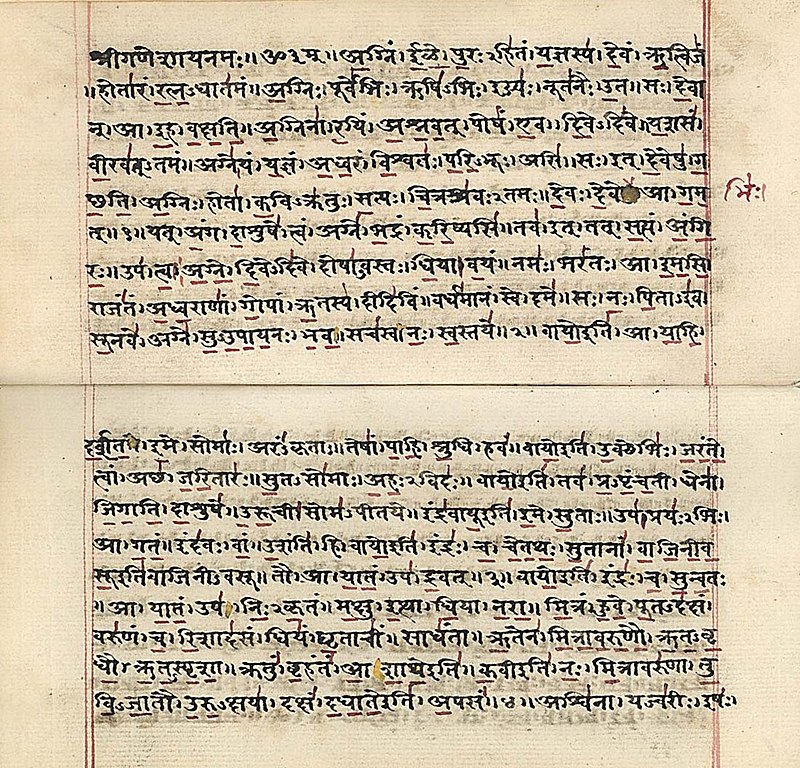Hindu Scriptures
Sanskrit literature can be classified under six orthodox heads and four secular heads. The six orthodox sections form the authoritative scriptures of the Hindus. The four secular sections embody the later developments in classical Sanskrit literature.
The six scriptures are: (i) Srutis, (ii) Smritis, (iii) Itihasas, (iv) Puranas, (v) Agamas and (vi) Darsanas.
The four secular writings are: (i) Subhashitas, (ii) Kavyas, (iii) Natakas and (iv) Alankaras.
The Scriptures


Revealed Truths Without Beginning or End
The Four Vedas and Their Sub Divisions
Rigveda (Rig Veda):
- Samhitas: The main part of the Rigveda consists of the Samhitas, which are collections of hymns and praises dedicated to various deities. The Rigveda Samhita is the oldest of the four Vedas.
- Brahmanas: These texts provide explanations and instructions for the rituals and ceremonies mentioned in the Samhitas.
- Aranyakas: The Aranyakas are considered the “forest treatises” and contain further explanations of rituals, as well as philosophical teachings.
- Upanishads: These are the most philosophical and esoteric texts, often considered the culmination of Vedic thought. The Upanishads explore metaphysical and spiritual concepts.
Yajurveda (Yajur Veda):
- Shukla Yajurveda: It is primarily in prose and deals with the rituals and ceremonies.
- Krishna Yajurveda: This Veda is in both prose and verse and also deals with rituals. It is further divided into the Taittiriya and Katha Shakhas.
Samaveda (Sama Veda):
- Samhitas: The Samaveda consists of chants and melodies derived from the Rigveda and is used during religious rituals.
- Ganas: These are like musical notations that help in the proper recitation and singing of the Samavedic hymns.
Atharvaveda (Atharva Veda):
- Samhitas: The Atharvaveda contains hymns and spells for everyday life, addressing a wide range of topics including healing, magic, and rituals.
- Brahmanas: These texts provide explanations for the rituals and ceremonies.
- Aranyakas: Like in other Vedas, these texts contain further explanations and philosophical teachings.
- Upanishads: The Atharvaveda also has its own set of Upanishads, which delve into philosophical and metaphysical matters.

The Celebrated Hindu Law-Givers
The Friendly Treatises and the Commanding Treatises

The Ramayana
Bala Kanda (The Book of Youth): This section introduces Lord Rama’s birth, childhood, and early life. It also describes his marriage to Sita and the events leading up to his exile.
Ayodhya Kanda (The Book of Ayodhya): This book narrates the events in the city of Ayodhya, including the exile of Rama, the grief of his family, and the scheming of Kaikeyi.
Aranya Kanda (The Book of the Forest): Rama, Sita, and his brother Lakshmana live in exile in the forest. This section details their encounters with various demons, including Surpanakha, Shurpanakha, and Ravana.
Kishkindha Kanda (The Book of Kishkindha): This book tells the story of Rama’s alliance with the monkey king Sugriva, the killing of Vali, and the search for Sita.
Sundara Kanda (The Book of Beauty): This section mainly focuses on Hanuman’s heroic journey to Lanka to locate Sita and deliver Rama’s message to her. Hanuman’s exploits are highlighted here.
Yuddha Kanda (The Book of War): The Yuddha Kanda describes the epic battle between Rama and Ravana, the demon king of Lanka. Rama’s victory and the rescue of Sita are major events in this book.
Uttara Kanda (The Book of Concluding): This final book deals with Rama’s return to Ayodhya, his coronation as king, and the events following his return, including the banishment of Sita and the birth of Rama’s sons, Lava and Kusha.

